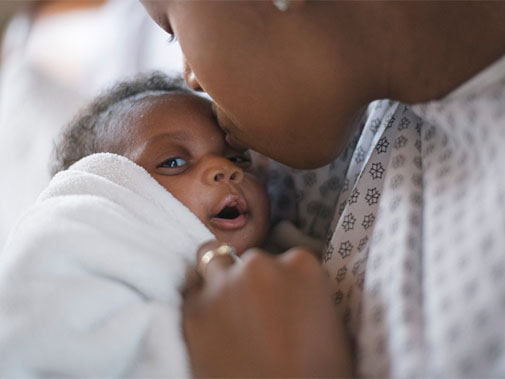Family-Centered Cesareans

Our family-centered cesarean is another way we ensure that every birth experience is special. By offering small but significant changes to the cesarean procedure, we make it possible for you to focus on the birth rather than surgery. Moms who opt for a family-centered cesarean can:
- View the birth through a clear plastic drape
- Have immediate skin-to-skin contact with baby, which can improve breastfeeding
- The safety and well-being of you and your baby is our top priority, and there are certain medical situations in which a family-centered approach would not be possible."I was adamant about doing skin-to-skin and expressed my wishes with the staff, who were happy to make it happen." - Patricia C.
If you have a scheduled Cesarean birth:
- Only one support person may accompany you during your cesarean birth.
- You will receive a phone call the evening before your delivery from a Birthplace nurse. She will give specific instructions regarding preparation for surgery.
- Please call the Nurse-in-Charge at 978.354.3330 if you have any questions
- Plan to arrive at the Birthplace two hours prior to your scheduled cesarean birth.
Anesthesia during surgery
- You will meet your anesthesiologist to discuss the various types of anesthesia and the advantages and disadvantages of each. An intravenous (IV) line will be started that will administer fluids and medication during and after your cesarean birth.
- In the operating room you will receive oxygen from a mask placed over your nose and mouth (the plastic may have a strange odor). The majority of scheduled cesarean births are performed under spinal anesthesia.
- You will be in the operating room for about one hour. A Foley catheter, which is used to drain urine from your bladder, will be inserted after you have anesthesia.
- After your baby is born and has received preliminary care, your baby can stay with you in the operating room.
Post-surgery
If you had a spinal or epidural anesthetic, you will stay in the recovery room until you can move your legs (about one to two hours). Your vital signs, lochia (vaginal bleeding), fundus (uterus) and abdominal dressing will be checked. For your safety, only your baby and support person will be allowed with you in the recovery room until you are transferred to your post-partum room. No other visitors are allowed in the recovery area.
- You will be encouraged to get out of bed as soon as you are able.
- The Foley catheter will be removed the next morning, and the IV is usually removed 24 to 48 hours after giving birth.
- Your physician will prescribe pain medication in one of two ways: on a "when needed" basis, (i.e. when you ask the nurses for it) or a "patient controlled analgesia" (PCA) pump that administers medicine through your IV when you need it.
- On your first day, we recommend you take pain medication at regular intervals to control the pain. The discomfort from your incision should lessen with each day.

